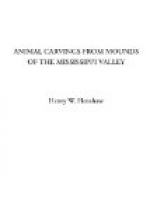Archaeologists must certainly deem it unfortunate that outside of the Wisconsin mound the only evidence of the co-existence of the Mound-Builder and the mastodon should reach the scientific world through the agency of one individual. So derived, each succeeding carving of the mastodon, be it more or less accurate, instead of being accepted by archaeologists as cumulative evidence tending to establish the genuineness of the sculptured testimony showing that the Mound-Builder and mastodon were coeval, will be viewed with ever increasing suspicion.
This part of the subject should not be concluded without allusion to a certain class of evidence, which, although of a negative sort, must be accorded very great weight in considering this much vexed question. It may be asked why if the Mound-Builders and the mastodon were contemporaneous, have no traces of the ivory tusks ever been exhumed from the mounds? No material is so perfectly adapted for the purposes of carving, an art to which we have seen the Mound-Builders were much addicted, as ivory, both from its beauty and the ease with which it is worked, to say nothing of the other manifold uses to which it is put, both by primitive and civilized man. The mastodon affords an abundant supply of this highly prized substance, not a particle of which has ever been exhumed from the mounds either in the shape of implements or carving. Yet the exceedingly close texture of ivory enables it to successfully resist the destroying influences of time for very long periods—very long indeed as compared with certain articles which commonly reward the search of the mound explorer.
Among the articles of a perishable nature that have been exhumed from the mounds are large numbers of shell ornaments, which are by no means very durable, as well as the perforated teeth of various animals; sections of deers’ horns have also been found, as well as ornaments made of the claws of animals, a still more perishable material. The list also includes the bones of the muskrat and turtle, as of other animals, not only in their natural shape, but carved into the form of implements of small size, as awls, etc. Human bones, too, in abundance, have been exhumed in a sufficiently well preserved state to afford a basis for various theories and speculations.
But of the mastodon, with which these dead Mound-Builders are supposed to have been acquainted, not a palpable trace remains. The tale of its existence is told by a single mound in Wisconsin, which the most ardent supporter of the mastodon theory must acknowledge to be far from a facsimile, and two carvings and an inscribed tablet, the three latter the finds of a single explorer.
Bearing in mind the many attempts at archaeological frauds that recent years have brought to light, archaeologists have a right to demand that objects which afford a basis for such important deductions as the coeval life of the Mound-Builder and the mastodon, should be above the slightest suspicion not only in respect to their resemblances, but as regards the circumstances of discovery. If they are not above suspicion, the science of archaeology can better afford to wait for further and more certain evidence than to commit itself to theories which may prove stumbling-blocks to truth until that indefinite time when future investigations shall show their illusory nature.




